Your cart is currently empty!
In Progress » Remora Pair » Remora Paint-ups » Part 1
Been a very busy modeler since the last update. The nature of the paint-work, inspiration, and following Ian’s painting is making painting and chipping one part at a time a necessity for my own sanity. It’s very enjoyable and I love the challenge of interpreting Ian’s painting into realistic paint and chips on a physical model. I’m also working on my own color scheme version inspired by Ian’s other paintings so let’s break down how I’ve done everything so far.
Build-up for Ian McQue:
After I did the base rust colors shown in the last update, I sprayed the entire hull in hairspray and let it air-dry. When dry I first sprayed on a thin base of white to make the next red mix pop. After I immediately sprayed a mixture of Tamiya Red, White, and Earth to get the faded old red color. Then I staded it streaking up and down focusing on the underside with a dark warm gray color. Tamiya Acrylics works best for the hairspray technique. Do not use enamels, lacquers or Vallejo for this.
I let the paint cure for only about 10-15 minutes then began chipping away at the red using a stiff brush and a needle to smaller scratches. Heavier chipping was added around the entryways and edges.
I removed much of the paint from the deck, but will paint the deck in grays and rusts later after masking the sidewalls.
After the chipping was complete I gave the hull a thin coat of Future Floor Acrylic to seal the red and chips. I waited about 6 hours then sprayed on a more hairspray then a random coat of minty blues and whites focusing on the rear and front of the ship based on Ian’s Remora painting.
I chipped away at the “mint” coat revealing the reds and rusts beneath. I love this multi-layered approach to painting chips as it adds a lot of depth and visual interest.
Afterwards I gave the hull another thin coat of Future to seal the blues. While that was curing I started on the fins. Using the box art as reference I did the same hairspray steps as above using custom mixes of Tamiya acrylics and tape to get the desired look.
I asked Ian what the fins on the opposite side looked like as I assumed they weren’t mirrored and he sent me a quick render. Using that ref I did what you see below. Next I’ll start on the deck and wheelhouse painting.
Build-up for FichtenFoo:
Meanwhile I was working on my personal Remora build-up. I started off with a layer of hairspray then painted the deck and inner walls in Nato Black oversprayed with Khaki to highlight it.
On the outside I sprayed custom mixes of cool blue-green grays. I then chipped this quite heavily using a toothbrush. I gave the hull a thin coat of Future and let it cure overnight.
The next day I applied more hairspray, then more custom mixes. First some Tamiya “Sky”, then over that lightened Tamiya White + Blue, then straight blue for panel edging using some post-its to define the edges.
I masked the blue and painted the orange front by first laying down some white, then the orange. Afterwards I removed the tape and began chipping the blues and oranges. You can see towards the front of the blue where the grays from the first coat start to show through on the chips.
When I was done with the blues and oranges, I wanted to add some random yellow chips to the rear. I tore off some wide Tamiya tape with rough edges and masked the areas I wanted yellow. Then I used my airbrush to put down some of the AK-Interactive chipping fluid. It works just like hairspray, but can be airbrushed making it great for spot-work like this.
I sprayed the white, then yellow and removed the masking. Then I took a wet toothbrush and chipped away most of the yellow. The end result gives that mottled colorful feel that you see in Ian McQue’s paintings.
That’s if so far. Watch for more on the next update!







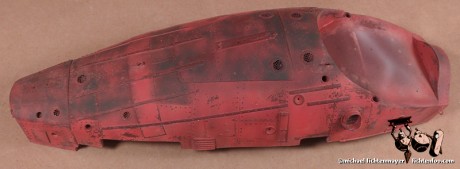
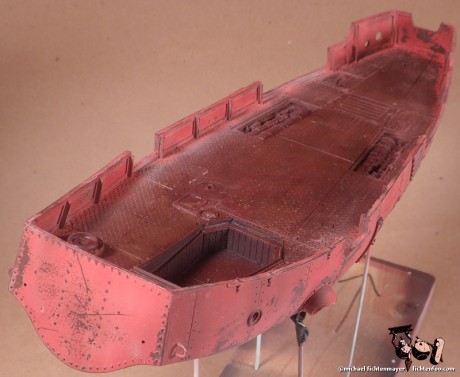

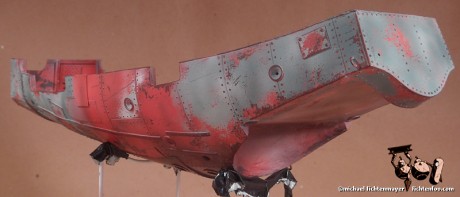





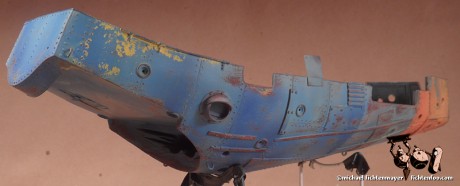

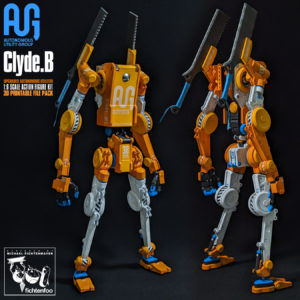
![Maude [Cyborg Action-Doll] (Files Only)](https://fichtenfoo.net/blog/wp-content/uploads/2023/01/Maude-Promos-300x300.jpg)


